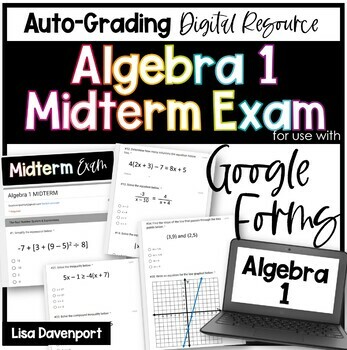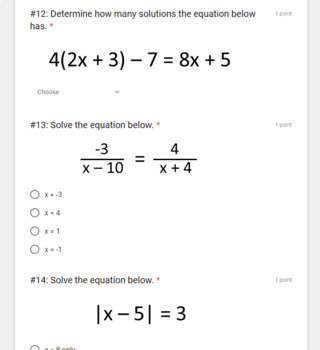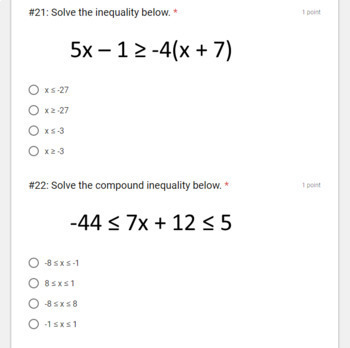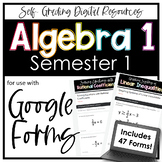Algebra 1 Midterm Exam for use with Google Forms
- Google Drive™ folder

What educators are saying
Also included in
- This bundle includes all SEMESTER 1 algebra 1 digital Google Forms assignments and quizzes that I have created. Every assignment also includes a "worksheet" that corresponds with the questions on each form. This bundle is priced at 50% off the sum of its contents, the lowest TPT will allow. Not 1Price $42.50Original Price $84.75Save $42.25
Description
This 49- question, self-grading Google Forms exam assesses students on the first half of algebra 1. This may be used as the actual mid-term exam, review for a mid-term exam, refresher after winter break, end-of-course review, or part of an algebra 1 refresh for geometry or algebra 2 students.
Questions are organized as follows:
Section 1: Enter email
Section 2: The Real Number System & Expressions
(Order of Operations, Evaluating Algebraic Expressions, Classify Real Numbers, Interpret Algebraic Expressions, Simplify Algebraic Expression, Distributive Property)
Section 3: Solving Equations
(Properties of Equality, Solve Two- Step, Multi- Step, Determine Solutions, Algebraic Proportions, Absolute Value Equations, Literal Equations)
Section 4: Graphing & Solving Inequalities
(Graph Single & Compound Inequalities, Solve One-Step, Two- Step, Multi- Step, Compound, & Absolute Value Inequalities)
Section 5: Introduction to Functions
(Identify Functions, Identify Linear Functions, Identify Domain of Discrete & Continuous Functions, Key Features of Graphs, Evaluate Functions, Arithmetic Sequences)
Section 6: Linear Functions
(Find Slope Given a Graph or Two Points, Write Equations in Slope- Intercept Form, Graph Linear Equations using Slope- Intercept Form and Intercepts, Graph Absolute Value Functions, Write Functions)
Section 7: Systems of Linear Equations & Inequalities
(Solve Linear Systems by Graphing, Substitution, & Elimination, Determine Solutions/ Special Solutions, Write & Solve Systems for a Real- World Problem, Graph Linear Inequalities, Graph Systems of Linear Inequalities)
This download also includes a PDF "worksheet" with the exact same questions as the Google Form. Just assign digitally or print + go!
This assignment is also included in my:
Algebra 1 Google Forms (Semester 1) Bundle
You may be interested in some of my other Google Forms Bundles:
- 6th Grade Math
- 7th Grade Math
- 8th Grade Math/ Pre-Algebra
- Algebra 1 Semester 1
- Algebra 1 Semester 2
- High School Geometry
- Algebra 2
You may also be interested in some of my foldable bundles:
★ 5th Grade Foldable + Activity Bundle
★ 6th Grade Math Foldable + Activity Bundle
★ 7th Grade Math Foldable + Activity Bundle
★ 8th Grade Math (Pre-Algebra) Foldable + Activity Bundle
★ Algebra 1 (+Pre-Algebra) Foldable Bundle
★ High School Geometry Foldable Bundle
Questions, concerns, or requests?
Please email me at Lisa@LisaDavenportOnTPT.com






